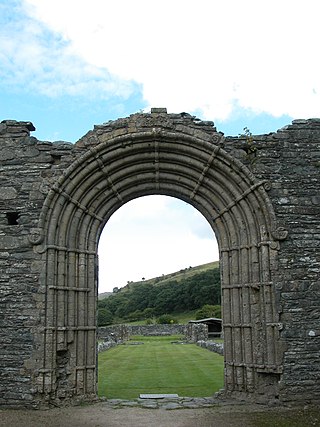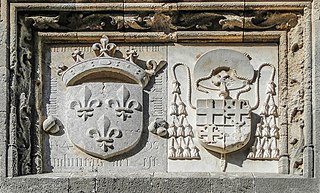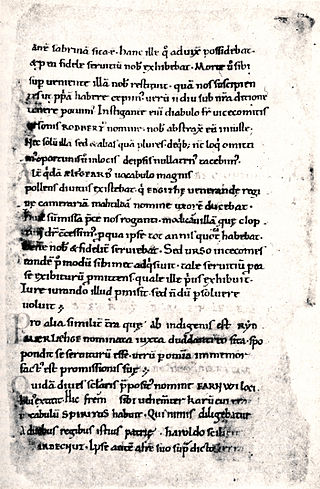
Ealdred was Abbot of Tavistock, Bishop of Worcester, and Archbishop of York in early medieval England. He was related to a number of other ecclesiastics of the period. After becoming a monk at the monastery at Winchester, he was appointed Abbot of Tavistock Abbey in around 1027. In 1046 he was named to the Bishopric of Worcester. Ealdred, besides his episcopal duties, served Edward the Confessor, the King of England, as a diplomat and as a military leader. He worked to bring one of the king's relatives, Edward the Exile, back to England from Hungary to secure an heir for the childless king.

Worcestershire is a ceremonial county in the West Midlands of England. It is bordered by Shropshire, Staffordshire, and the West Midlands county to the north, Warwickshire to the east, Gloucestershire to the south, and Herefordshire to the west. The city of Worcester is the largest settlement and the county town.

Worcester Cathedral, formally the Cathedral Church of Christ and Blessed Mary the Virgin, is a Church of England cathedral in Worcester, England. The cathedral is the seat of the bishop of Worcester and is the mother church of the diocese of Worcester; it is administered by its dean and chapter. The cathedral is a grade I listed building and part of a scheduled monument.

Strata Florida Abbey is a former Cistercian abbey situated just outside Pontrhydfendigaid, near Tregaron in the county of Ceredigion, Wales. The abbey was founded in 1164. After the region around St Davids was firmly occupied by the Norman Marcher lordship of Pembroke by the early 12th century, with St Davids firmly under Norman influence thereafter, the princely Dinefwr family of Deheubarth transferred their patronage to Strata Florida, and interred many of their family members there.

Wulfstan was an English Benedictine monk who served as Bishop of Worcester from 1062 to 1095. He was the last surviving pre-Conquest bishop. Wulfstan is a saint in the Western Christian churches.
Wulfstan was an English Bishop of London, Bishop of Worcester, and Archbishop of York. He is thought to have begun his ecclesiastical career as a Benedictine monk. He became the Bishop of London in 996. In 1002 he was elected simultaneously to the diocese of Worcester and the archdiocese of York, holding both in plurality until 1016, when he relinquished Worcester; he remained archbishop of York until his death. It was perhaps while he was at London that he first became well known as a writer of sermons, or homilies, on the topic of Antichrist. In 1014, as archbishop, he wrote his most famous work, a homily which he titled the Sermo Lupi ad Anglos, or the Sermon of the Wolf to the English.

The area now known as Worcestershire has had human presence for over half a million years. Interrupted by two ice ages, Worcestershire has had continuous settlement since roughly 10,000 years ago. In the Iron Age, the area was dominated by a series of hill forts, and the beginnings of industrial activity including pottery and salt mining can be found. It seems to have been relatively unimportant during the Roman era, with the exception of the salt workings.

Great Malvern Priory in Malvern, Worcestershire, England, was a Benedictine monastery and is now an Anglican parish church. In 1949 it was designated a Grade I listed building. It is a dominant building in the Great Malvern Conservation area. It has the largest display of 15th-century stained glass in England, as well as carved misericords from the 15th and 16th century and the largest collection of medieval floor and wall tiles. In 1860 major restoration work was carried out by Sir George Gilbert Scott. It is also the venue for concerts and civic services.

Bordesley Abbey was a 12th-century Cistercian abbey near the town of Redditch, in Worcestershire, England.

A langue or tongue was an administrative division of the Knights Hospitaller between 1319 and 1798. The term referred to a rough ethno-linguistic division of the geographical distribution of the Order's members and possessions. Each langue was subdivided into Priories or Grand Priories, Bailiwicks and Commanderies. Each langue had an auberge as its headquarters, some of which still survive in Rhodes, Birgu and Valletta.
In the Middle Ages, a commandery was the smallest administrative division of the European landed properties of a military order. It was also the name of the house where the knights of the commandery lived. The word is also applied to the emoluments granted to a commander. They were the equivalent for those orders to a monastic grange. The knight in charge of a commandery was a commander.

Holy Trinity Church is a Church of England parish church in Westbury-on-Trym, Bristol, England.

St Mary the Virgin is a Church of England parish church in Henbury, Bristol, England.

Dudley Priory is a dissolved priory in Dudley, West Midlands, England. The ruins of the priory are located within Priory Park, alongside the Priory Estate, and is both a scheduled monument and Grade I listed. The ruins received this status on 14 September 1949.

The Commandery is a historic building open to visitors and located in the city of Worcester, England. It opened as a museum in 1977 and was for a while the only museum in England dedicated solely to the Civil Wars. The Commandery ceased to be a Civil War museum when it reopened to the public in May 2007, having undergone a year and a half of refurbishments and reinterpretation jointly funded by the Heritage Lottery Fund and Worcester City Council, who own the building. It is a Grade I listed building.
Urse d'Abetot was a Norman who followed King William I to England, and became Sheriff of Worcestershire and a royal official under him and Kings William II and Henry I. He was a native of Normandy and moved to England shortly after the Norman Conquest of England in 1066, and was appointed sheriff in about 1069. Little is known of his family in Normandy, who were not prominent, but he probably got his name from the village Abetot. Although Urse's lord in Normandy was present at the Battle of Hastings, there is no evidence that Urse took part in the invasion of England in 1066.

Hemming's Cartulary is a manuscript cartulary, or collection of charters and other land records, collected by a monk named Hemming around the time of the Norman Conquest of England. The manuscript comprises two separate cartularies that were made at different times and later bound together; it is in the British Library as MS Cotton Tiberius A xiii. The first was composed at the end of the 10th or beginning of the 11th century. The second section was compiled by Hemming and was written around the end of the 11th or the beginning of the 12th century. The first section, traditionally titled the Liber Wigorniensis, is a collection of Anglo-Saxon charters and other land records, most of which are organized geographically. The second section, Hemming's Cartulary proper, combines charters and other land records with a narrative of deprivation of property owned by the church of Worcester.

Blackfriars Priory was a medieval Dominican priory dating back to the thirteenth century. The remains of the priory, located in Hereford, England, consist of monastery ruins, a cemetery, and a stone preaching cross. The ruins are surrounded by a rose garden established by the local community in 1964.

Thomas Wylde of The Commandery, Worcester, England, was a wealthy and prominent cloth merchant.

Worcester's early importance is partly due to its position on trade routes, but also because it was a centre of Church learning and wealth, due to the very large possessions of the See and Priory accumulated in the Anglo-Saxon period. After the reformation, Worcester continued as a centre of learning, with two early grammar schools with strong links to Oxford University.


















